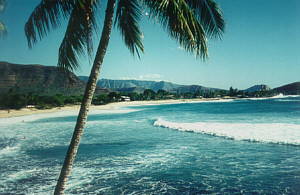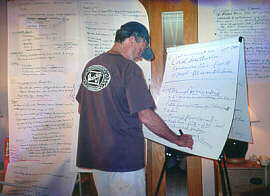
 |
| Makua Beach, Hawaii |  |
The U.S. Marine Corps has been practicing amphibious training on the beaches of Hawaii since World War II. For an EA begun in 1997, it wanted to sustain its training options at Makua Beach in a cooperative manner with the community, and to be sure that community impacts and environmental justice issues were adequately addressed. JKA engaged in informal community contact and description by entering the routines of the local communities.
 John Ryan in Makua Project Field Office. JKA Group set up on site to conduct its community descriptions from which the social, culture and economic assessments are drawn. |
The team found many issues of which the NEPA study group was unaware. Primary among them was the lack of compensation for families displaced from the Makua Valley in the original military take over during World War II. Early community work identified the informal networks and their cultural maintenance, survival, and caretaking systems. In addition to identifying citizen issues, the JKA team also described the "civic protocols" necessary for ongoing successful interaction with the many sub-cultures in the area.
Prior to JKA's involvement, the NEPA process was being "captured" by organized militants from the urban zones of Hawaii. The strategy of the militants was to disrupt NEPA by advocating for the importance of Makua as a sacred beach. As community workers identified elders in the local communities, the elders did not support the notion of a sacred beach-"What, you think we didn't walk on our beaches?" They pointed to specific sites on the beach that were culturally important and could not be disturbed by any civilian or military activity. As this level of detail was injected into the EA process, the militants were less able to dominate the process and to bring forward their ideological agenda. They had to be more responsible or lose standing in the informal community because the latter understood: "how the training activity, through enhancements to the culture, can directly benefit community members. Therefore, the training becomes a mutual benefit, with the community networks standing between the military and the activists."
 Jim Kent working with the field descriptions collected during reflections sessions with the field describers. |
Clarifying issues and devising ways to mitigate impacts based on informal approaches to community input (i.e., oral history interviews and community description) addresses Environmental Justice (EJ) requirements in the NEPA process and builds citizen ownership.
The reports for this work can be reviewed at:
For a summary discussion of the entire Makua Beach project, see:
"Including the Excluded Population in Marine Corps Environmental Decisions", The Marine Corps Gazette, October, 2000, pp. 41-42.